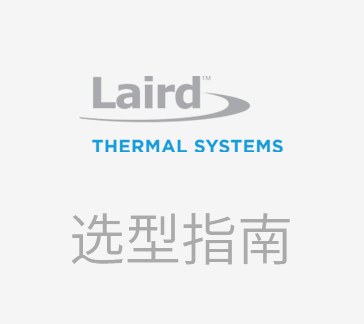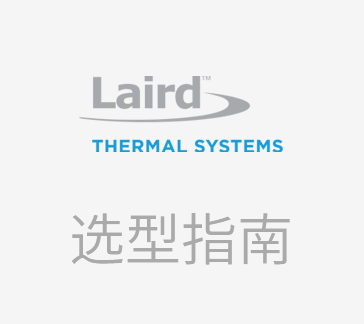Advanced Liquid Cooling for Rheometers Laird Thermal Systems™ Application Note
●Introduction: Rheometers are scientific instruments used for studying the stress-strain relationship of polymers, fluids, and other soft materials to understand their flow/deformation properties. Rheometers are applied in a wide range of applications, such as in the development of new materials, quality control, and process optimization. Any rheometer that operates at elevated temperatures or measures temperature-dependent material properties requires a cooling system to maintain a precise temperature during testing. The specific type of cooling system used will depend on the requirements of the test and the properties of the sample.
●Conclusion: Rheometer temperature control requirements hinge on the material being tested and the specific rheological properties that need to be measured. Materials have different temperature- dependent properties, so the cooling requirements will vary depending on the material being tested. Thus, the choice of cooling system will depend on factors such as the required temperature range, the volume of the sample, and the specific rheological test being performed. Recirculating chillers that have environmental benefit are becoming the preferred method for cooling medium to large volume rheometers. Some rheometers may use a combination of cooling systems, such as a recirculating chiller and thermoelectric component, to provide greater flexibility and control over the temperature of the sample. The Nextreme Recirculating Chillers Platform provides more consistent and precise temperature control compared to other cooling solutions, making it an ideal choice for the large number of rheometer applications.
●Types of Rheometers:
■Rheometers work by applying controlled deformation or stress to a material and measuring the resulting response. The deformation can be applied in various ways, such as through rotational or oscillatory motion, shear flow, compression, or extension. The resulting response can be measured in terms of parameters such as viscosity, elasticity, shear modulus, yield stress, and other rheological properties.
■There are several types of rheometers available, each designed for specific applications and material properties. Some common types of rheometers include:
▲Rotational: measure the torque and angular velocity of a sample while it is rotated or sheared. Rotational rheometers are versatile and can be used to test a wide range of materials, including liquids, pastes, and gels.
▲Oscillatory: apply small, sinusoidal deformations to a sample and measure the resulting stress and strain. Oscillatory rheometers are particularly useful for studying the viscoelastic properties of materials, including their storage and loss moduli. 4
▲Capillary: measure the flow properties of materials as they pass through a narrow, cylindrical tube. Capillary rheometers are commonly used to study the flow behavior of polymers, particularly in extrusion and injection molding processes.
▲Extensional: measure the extensional properties of materials, including their elongational viscosity and extensional stress. Extensional rheometers are used in applications such as polymer processing, fiber spinning, and coating.
▲Cone-and-plate: consists of a rotating cone that is pressed against a stationary plate, creating a shear flow in the sample. Cone-and-plate rheometers are commonly used to study the rheological properties of liquids and semi-solid materials.
▲Micro: designed for measuring the rheological properties of small samples, such as biological tissues or microfluidic systems. Micro-rheometers can be based on any of the above principles but are adapted for smaller-scale samples.
| 世强硬创平台www.sekorm.com | |
| 世强硬创平台电子商城www.sekorm.com/supply/ | |
| 世强硬创平台www.sekorm.com | |
| 世强硬创平台www.sekorm.com |
- +1 Like
- Add to Favorites
All reproduced articles on this site are for the purpose of conveying more information and clearly indicate the source. If media or individuals who do not want to be reproduced can contact us, which will be deleted.
Recommend
OEM Perspectives: Recirculating Chillers for Low-Power Lasers
2022/5/5 - Application note & Design Guide
基于热电或PELTIER的再循环冷却器,RECIRCULATING CHILLERS,THERMOELECTRIC- OR PELTIER- BASED RECIRCULATING CHILLERS,热电循环冷却器,循环式冷水机组,THERMOELECTRIC RECIRCULATING CHILLER,NRC400
More Version(s)Multistage Micro Thermoelectric Coolers for Miniature Optical Image Sensing Applications
2023/6/8 - Application note & Design Guide
MICRO MULTISTAGE THERMOELECTRIC COOLERS,LTS-MULTISTAGE MICRO THERMOELECTRIC COOLERS,冷却图像传感器,OPTICAL TEA,多个单级热电TEC,COOLING IMAGE SENSORS,微型多级热电制冷器,MICRO MULTISTAGE TECS,LTS-多级微型热电制冷器,级联热电模块,MULTISTAGE TECS,热电冷却器,MICRO THERMOELECTRIC COOLERS,MULTISTAGE MICRO TECS,多级微型热电制冷器,OPTICAL TEAS,MULTIPLE SINGLE-STAGE THERMOELECTRIC TECS,MULTISTAGE MICRO THERMOELECTRIC COOLER,TEAS,多级微型TEC,CASCADE THERMOELECTRIC MODULE,TECS,微型热电冷却器,THERMOELECTRIC COOLER,影像传感器,MULTISTAGE MICRO THERMOELECTRIC COOLERS,多级TEC,TEA,TEC,光TEA,单级热电制冷器,IMAGE SENSOR,SINGLE-STAGE THERMOELECTRIC COOLER,微型多级TEC,MSX,MSX SERIES
Enhancing Performance in Portable and Bench-Top X-Ray Detectors with Thermoelectric Coolers
2025/02/19 - Application note & Design Guide
X射线探测器冷却解决方案,THERMOELECTRIC COOLERS,X-RAY DETECTOR COOLING SOLUTIONS,热电冷却器
Thermoelectric Coolers
2022/1/18 - Selection guide THERMOELECTRIC COOLERS,热电冷却器,430478-502,HTX20-31-F2A-0909-11-W2.25,64979-501,CP085-127-06-L1-W4.5,UTX15-24-F2-5252-TA-W6,CP14-31-10-L1-W4.5,ETX7-3-F1-2020-TA-RT-W6,9360001-301,7050045-502,71061-504,ETX14-12-F1-6262-TA-W6,PCX SERIES,UTX6-24-F1-5555-TA-W6,HTX15-31-F2A-0909-TB-W2.25,PCX7-156-F2-1672-TA-RT-W6,387008429,SH08-28-05-L1-W4.5,PCX6-12-F1-4040-TA-RT-W6,CP14-71-10-L1-W4.5,ULTRATEC™ UTX SERIES,PCX8-12-F1-4040-TA-W6,9340006-301,71092-501,ETX4-7-F1-2323-TA-W6,PCX7-16-F1-4040-TA-W6,ETX15-28-F2-5252-TA-RT-W6,387008431,CP14-127-10-L1-W4.5,387007103,CP14-35-045-L1-W4.5,430705-503,ETX4-7-F2-3030-TA-RT-W6,387007106,387007227,387007108,HTX12-65-F2A-1312-TB-RT-W2.25,OPTOTEC™ HTX,430874-503,71062-514,387007231,CP08-63-06-L1-W4.5,387007112,387007113,9350004-301,387007115,430052-501,387007117,MS5-257-10-15-11-W8,ETX2.5-12-F1-3030-TA-RT-W6,CP08-127-05-L1-W4.5,PCX10-223-F1-3172-TA-RT-W6,CP14-127-045-L1-W4.5,HITEMP ETX SERIES,430922-501,387007120,387007123,387007122,9320002-301,MS3-119-20-15-11-W8,ETX11-12-F1-4040-TA-RT-W6,MS SERIES,56760-505,ETX15-12-F2-4040-TA-RT-W6,MS2-192-14-20-11-18-11-W8,ETX6-12-F1-4040-TA-RT-W6,56590-502,SH10-23-06-L1-W4.5,71036-505,56610-502,MS4-108-10-20-11-W8,ETX4-12-F1-3030-TA-W6,430027-501,PCX12-248-F1-5040-TA-RT-W6,PT4-7-F2-3030-TA-W6,430848-502,OTX12-65-F2A-1312-11-W2.25,430848-504,PCX8-7-F2-3030-TA-RT-W6,MS2-068-14-14-15-15-11-W8,CP14-71-045-L1-W4.5,PCX,OTX20-66-F0-1211-11-W2.25,PCX4-6-F1-2040-TA-RT-W6,HTX,PCX5-16-F1-4040-TA-W6,56430-501,OTX19-23-F1N-0608-11-W2.25,HTX SERIES,UTX9-28-F2-4040-TA-W6,PCX15-7-F1-4040-TA-RT-W6,PT4-12-F2-3030-TA-W6,CP12-161-04-L1-W4.5,16506-302,430875-503,PCX8-6-F1-2040-TA-RT-W6,ETX4-3-F1-2020-TA-RT-W6,43280-503,66100-501,66156-505,71063-505,44440-501,71020-505,56550-501,MS3-052-10-17-11-W8,387004692,387005660,71012-506,SH10-125-05-L1-W4.5,387005662,ETX2.3-4-F1-1919-TA-RT-W6,ETX5-6-F1-2040-TA-RT-W6,387005663,ETX4-12-F2-4040-TA-RT-W6,387005664,387004697,387005665,387005667,387005669,OTX12-66-F0-1211-11-W2.25,430097-507,ETX2.6-12-F1-2525-TA-W6,PCX9-3-F2-2525-TB-RT-W6,387005671,387005672,MS2-102-22-22-17-17-11-W8,387005673,387005674,387005676,387005677,387005678,387005679,387005318,CP10-254-06-L1-W4.5,ETX9-3-F2-2525-TA-W6,CP10-71-05-L1-W4.5,430026-503,430511-504,56910-502,OTX20-66-F0-1211-11-EP-W2.25,387005681,387006650,56995-501,387006891,387005683,CP10-31-05-L1-W4.5,ETX6-19-F1-4040-TA-RT-W6,387006893,387005685,387005686,387006534,387006897,HTX15-30-F2A-0610-11-W2.25,OTX12-65-F2A-1312-TB-W2.25,RH14-14-06-L1-W4.5,ETX2-12-F2-3030-TA-W6,PCX8-6-F1-3518-TA-RT-W6,MS2-102-14-14-17-17-11-W8,387006784,UTX15-288-F2-5252-TA-W6,387005696,387006544,387005698,387005699,ETX4-12-F1-4040-TA-RT-W6,SH14-125-10-L1-W4.5,CP14-71-06-L1-W4.5,9340001-301,HTX12-18-F2A-0606-11-RT-W2.25,ETX,387006791,387006795,CP2-127-10-L1-W4.5,387006798,63604-511,CP14-199-06-L1-W4.5,PCX6-24-F1-5555-TA-RT-W6,OTX20-65-F2A-1312-11-W2.25,PCX5.6-19-F1N-3030-TA-RT-W6,ETX15-24-F2-5252-TA-W6,MS3-231-10-15-11-W8,SH14-125-045-L1-W4.5,62910-510,POWERCYCLING PCX,387005354,PCX24-128-F2-5555-TA-RT-W6,HTX15-65-F2A-1312-TB-W2.25,POWERCYCLING PCX SERIES,CP10-131-04-L1-TOW-W4.5,OTX08-18-F0-0505-11-W2.25,HTX12-18-F2A-0606-GG-W2.25,CP14-199-045-L1-W4.5,CP2-71-06-L1-W4.5,ETX4-6-F2-2143-TA-RT-W6,OTX20-68-F1A-1313-11-W2.25,71212-502,OPTOTEC™ OTX SERIES,CP SERIES,CP2-31-06-L1-W4.5,63595-501,POLARTEC™ PT SERIES,PCX4-4-F1-1515-TA-RT-W6,ETX8-12-F2-2525-TA-RT-W6,HTX12-65-F2A-1312-11-W2.25,OTX08-31-F1-0707-11-RT-W2.25,PT8-12-F2-4040-TA-W6,ETX4-12-F2-3030-TA-RT-W6,CP10-71-06-L1-W4.5,OTX08-66-F0-1009-11-RT-W2.25,CP14-17-10-L1-W4.5,ETX11-12-F2-3030-TA-RT-W6,ETX3-3-F2-1518-TA-W6,PCX4-7-F1-2020-TA-RT-W6,387004970,MS2-190-10-10-12-12-11-W8,387005700,CP10-127-06-L1-W4.5,ETX2.5-12-F1-4040-TA-RT-W6,9340002-301,MS2-065-04-04-11-11-11-W4,71049-501,9350007-301,POLARTEC™ PT,387006926,PT4-12-F2-4040-TA-W6,387006928,387006927,PCX11-12-F2-3030-TA-RT-W6,RH14-32-06-L1-W4.5,MS2-051-22-25-22-25-11-W8,ETX14-3-F1-3030-TA-RT-W6,MS4-115-14-15-11-W8,PCX8-176-F2-7528-TA-RT-W6,SH14-15-06-L-W4.5,PCX7.5-13-F1-4023-TA-RT-W6,OTX15-68-F1A-1313-11-W2.25,CP2-127-06-L1-W4.5,ETX6-7-F2-3030-TA-RT-W6,OTX08-08-F0-0303-11-W2.25,PCX6-28-F2-4040-TA-RT-W6,44530-501,MS2-049-10-10-15-15-11-W8,16503-310,475010-313,ETX3-48-F1-1212-GG-W6,UTX8-288-F2-5252-TA-W6,ETX2.6-6-F1-1225-TA-W6,UTX6-19-F1-4040-TA-W6,430436-504,OPTOTEC™ OTX,387006832,387006834,387006836,387006837,9350006-301,387006839,HTX20-65-F2A-1312-11-W2.25,9380001-301,MS3-070-20-25-11-W8,9340003-301,MS2-192-14-20-15-25-11-W8,MS4-129-10-15-11-W8,PCX2-12-F1-3030-TA-RT-W6,ETX2-6-F1-1225-TA-RT-W6,ETX4-3-F1-1515-TA-RT-W6,387005513,387006845,387005514,387005515,387006847,387005516,ETX25-12-F1-6262-TA-W6,ETX1.6-12-F2-3030-TA-RT-W6,OTX12-66-F0-1211-TB-RT-W2.25,430023-507,9350001-301,HITEMP ETX,387004679,57180-501,CP10-63-06-L1-W4.5,71035-505,PCX4-139-F1-1850-TA-RT-W6,ETX SERIES,UTX8-12-F2-2525-TA-W6,430474-501,MS2-107-10-10-12-12-11-W8,ETX8-12-F1-4040-TA-RT-W6,UTX11-12-F2-3030-TA-W6,387004680,ETX6-3-F1-2020-TA-RT-W6,OTX SERIES,387004685,387005659,PCX15-128-F
More Version(s)Liquid Cooling Systems
Introduction Benefits & Applications of Liquid Cooling Systems Nextreme™ Recirculating Chillers Liquid Heat Exchangers Custom Liquid Cooling Systems Featured Application: Medical Imaging
050422 - Selection guide LIQUID COOLING SYSTEMS,RECIRCULATING CHILLERS,油基热交换器,水基热交换器,基于热电的循环制冷机,CABINET COOLERS,BENCHTOP RECIRCULATING CHILLER,COMPRESSOR-BASED RECIRCULATING CHILLERS,液体热交换器,LIQUID HEAT EXCHANGERS,WATER-BASED HEAT EXCHANGERS,LIQUID TO LIQUID COOLING SYSTEMS,液体-空气冷却系统,机柜冷却器,THERMOELECTRIC-BASED RECIRCULATING CHILLERS,循环式冷水机组,OIL-BASED HEAT EXCHANGERS,台式循环冷却器,液体对液体冷却系统,液体冷却系统,再循环冷水机,LIQUID TO AIR COOLING SYSTEMS,基于压缩机的循环制冷机,RECIRCULATING CHILLER,1510.00,WL1500,385901-001,VRC2400,VRC4500,NRC5000,WL3004,387008451,1550.00,LA5000,WL1000,385911-015,1520.00,387009925,OW4002,385910-043,387010178,387010179,NRC2400,1505.00,38701 0181,1264.00,1155.00,1104.00,VRC1200,WW5001,387002779,NRC400,WW3001,1515.00,WL500,WL2000,387005774,387005598,OL4503,385912-029,NRC1200,385910-015
Premium Thermoelectric Coolers from Laird Thermal Systems Deliver Precise Spot-cooling for Industrial Lasers
2025-09-23 - Product Introduction The UltraTEC™ UTX Series thermoelectric coolers from Laird Thermal Systems offer high reliability and long-life operation for industrial lasers and optoelectronics. Utilizing solid-state technology and advanced materials, the series achieves a 10% increase in heat pumping capacity and improved COP. With a maximum ΔT of 72°C and up to 296W capacity, they enable efficient spot cooling in compact, high-heat environments.
Laird Thermal Systems Launches PCX Thermoelectric Cooler Series to Increase Reliability of PCR Cycling
2024-09-14 - Product Introduction This paper mainly introduces the advantages of Laird Thermal Systems with regard to their PCX series Thermoelectric Coolers applications
Laird Thermal Systems Thermoelectric Coolers OptoTEC™, MBXOptoTEC™, OTXOptoTEC™ HTX for Optical Transceivers
2024-08-31 - Application solution Article This paper mainly introduces the application cases of several different series of thermoelectric coolers from Laird Thermal Systems for the optical module market
Laird Thermal Systems’ PowerCycling PCX Thermoelectric Coolers Enable Rapid PCR Point of Care Testing
2025-09-22 - Product Introduction The PowerCycling PCX Series thermoelectric coolers are designed to withstand demanding thermal cycling environments, particularly in point-of-care PCR testing. They offer high reliability, extended MTBF, and improved thermal performance in compact devices. Featuring a robust construction and soft layer to reduce mechanical stress, the series supports rapid temperature changes and high operating temperatures up to 120°C.
Laird Thermal Systems 341-Watt Thermoelectric Coolers for Handheld Cosmetic Laser Applications
2024-09-04 - Application solution Article The UltraTEC Series thermoelectric cooler has a heat pumping capacity up to 341 watts, which is ideal for ablative cosmetic lasers. The cooler is assembled with a large number of semiconductor couples to achieve a higher heat pumping capacity than standard single stage TEMs.
High-Capacity Thermoelectric Coolers from Laird Thermal Systems Maximize Laser Projector Performance
2025-09-22 - Product Introduction The new UltraTEC™ UTX Series of thermoelectric coolers maintains temperature stability in applications such as laser projectors that require high heat pumping capability…
Coherent Launches CT-Series Thermoelectric Coolers for Enhanced Thermal Management
2025-01-26 - Product Introduction Coherent Corp. announces the launch of its CT-Series thermoelectric coolers. This new product line delivers exceptional thermal performance, reliability, as well as cost-efficiency for demanding applications in life sciences, medical and industrial markets.
Selecting the Optimum Recirculating Chiller for Your Application
2025-08-30 - Device Selection Article Temperature control is critical for medical devices, laser systems, semiconductor metrology and fabrication, additive manufacturing, electron microscopes, and many laboratory instruments used in chemistry, biology, industrial, oil & gas, research, and food science.Recirculating chillers are liquid cooling systems that precisely control the temperature of water or water with glycol (antifreeze) in a liquid circuit over a broad setpoint and ambient temperature range while removing heat from a process or equipment.
Laird Thermal Systems Launches OptoTEC™ OTX/HTX Series of Miniature Thermoelectric Coolers for High-temperature Optoelectronics
2024-09-14 - Product Introduction Laird Thermal Systems has launched the enhanced OptoTEC™ OTX/HTX Series of miniature thermoelectric coolers designed for high-temperature environments found in telecom, industrial, autonomous and photonics applications.
Thermoelectric Chillers for Semiconductor Metrology & Inspection Systems
2024-09-29 - Application solution Article The NRC400 Nextreme™ Performance Chiller by Laird Thermal Systems is a thermoelectric-based chiller designed for semiconductor automated optical inspection (AOI) systems. It offers precise temperature control, high reliability, and low maintenance, making it ideal for 24/7 operations. The chiller helps maintain equipment uptime, reduce costs, and improve yield in semiconductor manufacturing.
Electronic Mall
 Auth. Dist.
Auth. Dist.
 Auth. Dist.
Auth. Dist.
 Auth. Dist.
Auth. Dist.
 Auth. Dist.
Auth. Dist.
Integrated Circuits
Discrete Components
Connectors & Structural Components
Assembly UnitModules & Accessories
Power Supplies & Power Modules
Electronic Materials
Instrumentation & Test Kit
Electrical Tools & Materials
Mechatronics
Processing & Customization







































































































































































































































































































































































































































































































































































































































































































































































































































































































































































































